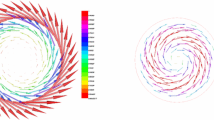Abstract
We consider mixed finite elements for the plane elasticity system and the Stokes equation. For the unmodified Hellinger-Reissner formulation of elasticity in which the stress and displacement fields are the primary unknowns, we derive two new nonconforming mixed finite elements of triangle type. Both elements use piecewise rigid motions to approximate the displacement and piecewise polynomial functions to approximate the stress, where no vertex degrees of freedom are involved. The two stress finite element spaces consist respectively of piecewise quadratic polynomials and piecewise cubic polynomials such that the divergence of each space restricted to a single simplex is contained in the corresponding displacement approximation space. We derive stability and optimal order approximation for the elements. We also give some numerical results to verify the theoretical results.
For the Stokes equation, introducing the symmetric part of the gradient tensor of the velocity as a stress variable, we present a stress-velocity-pressure field Stokes system. We use some plane elasticity mixed finite elements, including the two elements we proposed, to approximate the stress and velocity fields, and use continuous piecewise polynomial functions to approximate the pressure with the gradient of the pressure approximation being in the corresponding velocity finite element spaces. We derive stability and convergence for these methods.
Similar content being viewed by others
References
Amara M, Thomas J M. Equilibrium finite elements for the linear elastic problem. Numer Math, 1979 33: 367–383
Arnold D N, Awanou G. Rectangular mixed finite elements for elasticity. Math Models Methods Appl Sci, 2005, 15: 1417–1429
Arnold D N, Brezzi F, Douglas J Jr. Peers: A new mixed finite element for plane elasticity. Jpn J Appl Math, 1984, 1: 347–367
Arnold D N, Douglas J Jr, Gupta C P. A family of higher order mixed finite element methods for plane elasticity. Numer Math, 1984, 45: 1–22
Arnold D N, Falk R S. A new mixed formulation for elasticity. Numer Math, 1988, 53: 13–30
Arnold D N, Winther R. Mixed finite elements for elasticity. Numer Math, 2002, 92: 401–419
Arnold D N, Winther R. Nonconforming mixed elements for elasticity. Math Models Methods Appl Sci, 2003, 13: 295–307
Behr M A, Franca L P, Tezduyar T E. Stabilized finite element methods for the velocity-pressure-stress formulation of incompressible flows. Comput Methods Appl Mech Engrg, 1993, 104: 31–48
Bochev P B, Gunzburger M D. Least-squares for the velocity-pressure-stress formulation of the stokes equations. Comput Methods Appl Mech Engrg, 1995, 126: 267–287
Bochev P B, Gunzburger M D. Finite element methods of least- squares type. SIAM Review, 1998, 40: 789–837
Bramble J H, Lazarov R D, Pasciak J. Least-squares methods for linear elasticity based on a discrete minus one inner product. Comput Methods Appl Mech Engng, 2001, 191: 727–744
Brezzi F. On the existence, uniqueness and approximation of saddle point problems arising from Lagrange multipliers. RAIRO Numer Anal, 1974, 8: 129–151
Brezzi F, Fortin M. Mixed and Hybrid Finite Element Methods. Berlin: Springer-Verlag, 1991
Cai Z, Lee B, Wang P. Least-squares methods for incompressible newtonian fluid flow: Linear stationary problems. SIAM J Numer Anal, 2004, 42: 843–859
Cai Z, Manteuffel T A, McCormick S F. First-order system least squares for second-order partial differential equations: Part II. SIAM J Numer Anal, 1997, 34: 425–454
Chang C L. A mixed finite element method for the stokes problem: an accelerations-pressure formulation. Appl Math Comput, 1990, 36: 135–146
Farhloul M, Fortin M. Dual hybrid methods for the elasticity and the stokes problems: a unified approach. Numer Math, 1997, 76: 419–440
Farhloul M, Zine A M. A new mixed finite element method for the stokes problem. J Math Anal Appl, 2002, 276: 329–342
Fraejis de Veubeke B M. Displacement and equilibrium models in the finite element method. In: Zienkiewicz O C, Holister G, eds. Stress Analysis. New York: Wiley, 1965, 145–197
Franca L P, Stenberg R. Error analysis of Galerkin least squares methods for the elasticity equations. SIAM J Numer Anal, 1991, 28: 1680–1697
Girault V, Raviart P A. Finite Element Methods for Navier-Stokes Equations: Theory and Algorithms. Berlin-New York: Springer-Verlag, 1986
Gunzburger M D. Finite Element Methods for Viscous Incompressible Flows: A Guide to Theory, Practice, and Algorithms. London: Academic Press, 1989
Hu J, Shi Z C. Lower order rectangular nonconforming mixed finite elements for plane elasticity. SIAM J Numer Anal, 2007, 46: 88–102
Jiang B. The Least-Squares Finite Element Method: Theory and Applications in Computational Fluid Dynamics and Electro-Magnetics. Berlin: Springer, 1998
Johnson C. A mixed finite element method for the Navier-Stokes equations. RAIRO M2AN, 1978, 12: 335–348
Johnson C, Mercier B. Some equilibrium finite element methods for two-dimensional elasticity problems. Numer Math, 1978, 30: 103–116
Mignot A L, Surry C. A mixed finite element family in plane elasticity. Appl Math Model, 1981, 5: 259–262
Stein E, Rolfes R. Mechanical conditions for stability and optimal convergence of mixed finite elements for linear plane elasticity. Comput Methods Appl Mech Engrg, 1990, 84: 77–95
Stenberg R. On the construction of optimal mixed finite element methods for the linear elasticity problem. Numer Math, 1986, 48: 447–462
Stenberg R. A family of mixed finite elements for the elasticity problem. Numer Math, 1988, 53: 513–538
Stenberg R. Two low-order mixed methods for the elasticity problem. In: The Mathematics of Finite Elements and Applications, vol. VI. London: Academic Press, 1988, 271–280
Watwood Jr V B, Hartz B J. An equilibrium stress field model for finite element solution of two-dimensional elastostatic problems. Internat J Solids Structures, 1968, 4: 857–873
Author information
Authors and Affiliations
Corresponding author
Rights and permissions
About this article
Cite this article
Xie, X., Xu, J. New mixed finite elements for plane elasticity and Stokes equations. Sci. China Math. 54, 1499–1519 (2011). https://doi.org/10.1007/s11425-011-4171-3
Received:
Accepted:
Published:
Issue Date:
DOI: https://doi.org/10.1007/s11425-011-4171-3




